Welcome to National Nude Day on July 14th, a day usually bursting with fun as we celebrate the 'bare' essentials. This year, we're turning the spotlight on a special group of furry, or should we say 'fur-less', friends! This National Nude Day, we're honoring the naked, the bold, and the utterly captivating - the beloved hairless cats.
Contrary to the traditional image of cats as fluffy, fur-covered companions, we're challenging the status quo and throwing a fête for the felines that wear their skin with grace and style.
In this article, under the banner "Hairless Cats Steal the Spotlight on National Nude Day", we're ready to introduce you to the renowned, rare, and radiant hairless cat breeds.
From the popular Sphynx to the lesser-known Donskoy, we're not holding anything back - every detail will be laid bare. So let's get started! Let's celebrate these bald beauties.
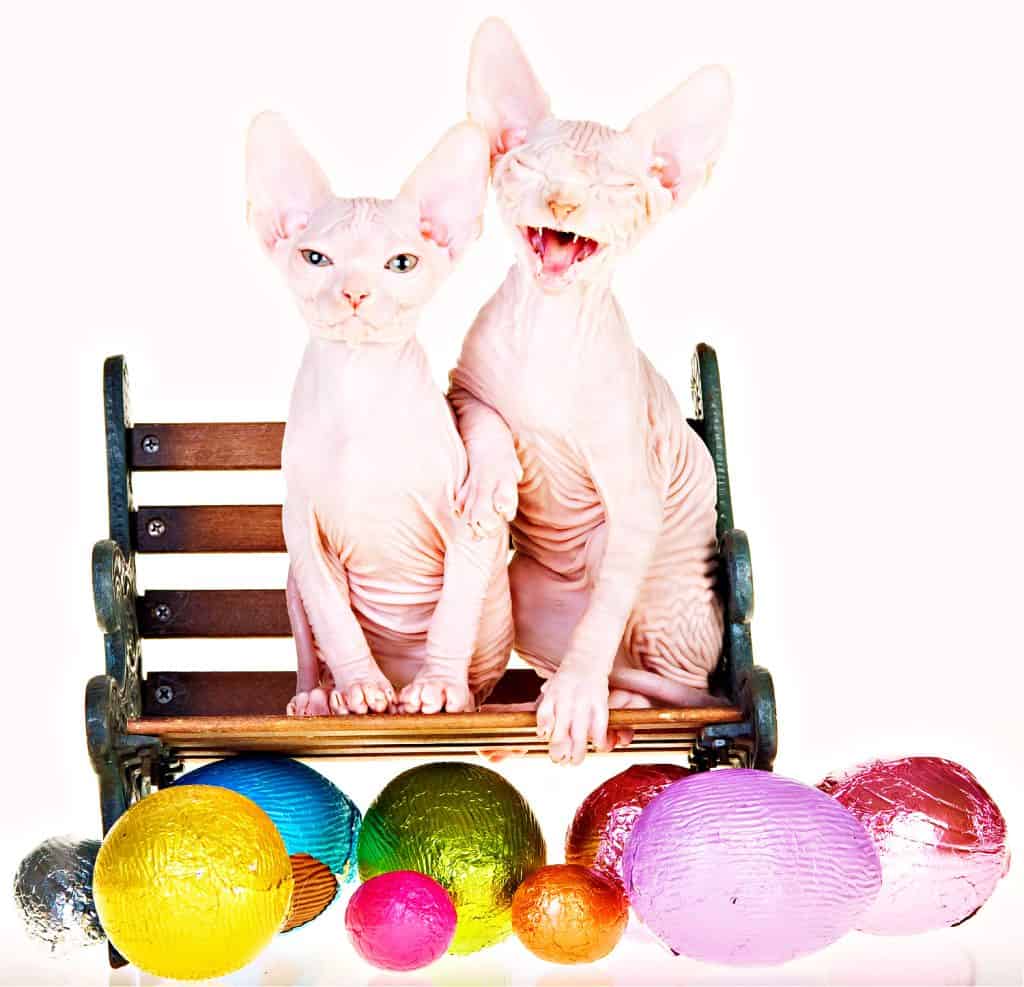
Our Featured Hairless Cat Breeds
This National Nude Day, we're celebrating the extraordinary breeds that are officially recognized by renowned international cat breeding associations like The International Cat Association (TICA) and the Cat Fanciers’ Association.
These organizations work diligently to uphold the purity and long-term health of these breeds through stringent specifications and breed standards.
We also feature a few bonus breeds that are either recently recognized, categorized as experimental, or have a bit of controversy. But what's National Nude Day without a bit of controversy?
Celebrating Hairless Beauty And Charm
So, as we journey into the beguiling world of hairless cat breeds, let's give a round of applause to these recognized stars, each one more intriguing than the last:
Hairless Breed #1: The Sphynx
The Sphynx: Majestic, with its fine wrinkles and skin softer than a peach.
Hairless Breed #2: The Bambino
The Bambino: This breed is a delightful blend of the Munchkin and Sphynx, resulting in a cat with short legs and a hairless body.
Hairless Breed #3: The Donskoy
The Donskoy: Also Russian-born, this breed is a truly rare sight to behold, with a mesmerizing muscular build and wedge-shaped head.
Hairless Breed #4: The Elf
The Elf: A bewitching mix of the Sphynx and the American Curl, resulting in a hairless cat with unique curled ears.
Hairless Breed #5: The Peterbald
The Peterbald: Grace personified, hailing from Russia, with its slender body and almond-shaped eyes.
Hairless Breed #6: The Ukrainian Levkoy
The Ukrainian Levkoy: Known for its unique, dog-like folded ears, this breed has a distinguished angular face, adding to its irresistible charm.
Hairless Breed #7: The Lykoi
The Lykoi: Also known as the 'Werewolf Cat', this breed is not entirely hairless. Their patchy coat gives them an enigmatic appeal.
Hairless Breed #8: The Minskin
The Minskin: A delightful fusion of the Munchkin's short legs, the Sphynx's hairlessness, and the Burmese's compact body structure.
Hairless Breed #9: The Dwelf
The Dwelf: This breed is a blend of the Munchkin, Sphynx, and American Curl. It has short legs, is hairless, and has curled ears.
Whether officially recognized or not, each of these breeds holds a unique spot in our hearts and certainly deserves its moment in the spotlight this National Nude Day. Here's to celebrating their captivating beauty and charm!
Hairless Breed #1: The Sphynx
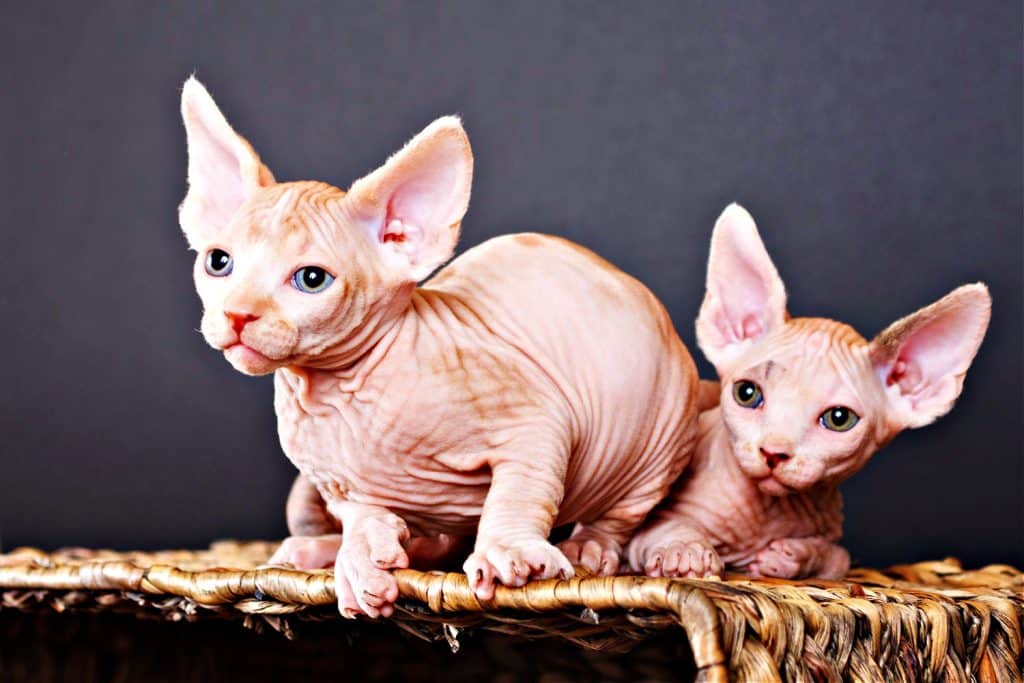
Embracing the Sphynx's Unique Charm
At first glance, the Sphynx cat's alien-like characteristics, with wrinkled face, large eyes, and broad ears, could be disconcerting.
But don't let their peculiar appearance mislead you. A Sphynx cat is a bundle of warmth, energy, and social charm that can easily melt your heart.
A Name With No Ancestral Connection: The Sphynx
Intriguingly, despite its name being reminiscent of The Great Sphinx of Giza in Egypt, the Sphynx breed shares no direct lineage with Egyptian cats.
This is a widespread misconception, given the symbolic link between ancient Egypt and cats, and the majestic image of the Sphinx.
In reality, the Sphynx's lineage traces back to Canada in the 1960s, far from the sandy landscapes of Egypt. The breed came to be through a natural genetic mutation that led to hairlessness in a domestic cat, a kitten named Prune.
Prune's hairless trait was found to be recessive and breeders, intrigued by this unique characteristic, embarked on a breeding program to replicate and stabilize the hairlessness trait. The result of this effort is the modern Sphynx we know and love today.
Physical Characteristics And Temperament Of The Sphynx
Whether you desire a heartwarming companion for your quiet nights spent watching TV, or a bubbly, affectionate presence to welcome you home after a long day, a Sphynx cat could be the perfect addition to your household.
Their endearing personality, replete with an instinctive sense of curiosity and sociability, creates a delightful atmosphere at home.
Sphynx cats are not just friendly with their human companions but are often harmoniously compatible with other pets. Their laid-back and approachable nature, combined with their intrinsic love for play and interaction, makes them suitable companions for children, other feline friends, and even dogs!
So, if you’re considering bringing a Sphynx into a multi-pet household, rest assured, they’re typically quite the social butterfly.
Contrary to popular belief, Sphynx cats aren't entirely hairless. A layer of tiny, fine hair coats their bodies, with short fur adorning their noses, paws, and the edges of their ears and tails.
Interestingly, the Sphynx maintains a higher body temperature than other cats, a response to their lack of fur.
This doesn't deter them from seeking warmth in cuddles or even wearing jackets.
Grooming A Hairless Star: Sphynx And Their Cleaning Needs
While they may lack a traditional fur coat, the grooming needs of Sphynx cats are no less important. Without the benefit of fur to absorb and distribute the natural oils their skin produces, these oils can build up on their skin.
This, combined with dust and dirt from their environment, can lead to skin problems if not properly managed. Regular baths with mild cat-friendly soap can help to keep their skin clean and healthy.
In addition, their ears also require special attention. Lacking ear hair, they can accumulate more earwax than other breeds. Regular, gentle cleaning with vet-recommended products can help prevent potential infections.
In essence, while their grooming routine is different from furry cats, it is just as crucial to their well-being.
Pop Culture Stars: Sphynx Cats in the Limelight
The Sphynx cat holds a notable place in pop culture, from Mr. Bigglesworth in the Austin Powers film series to the internet-famous Amsterdam with his Buddha-like pose and irresistible charm.
Sphynx Kittens And Respiratory Concerns
Being hairless, Sphynx kittens are particularly susceptible to environmental factors and airborne particles that can lead to respiratory complications.
Their lack of fur exposes them to temperature changes and allergens, potentially causing stress to their developing immune systems and leading to illnesses like colds and pneumonia.
Routine veterinary check-ups and maintaining a warm, clean environment are key to early detection and prevention. If needed, timely treatment may include medications, hydration, and nutritious food to strengthen their immune system and combat infections.
Despite their unique vulnerabilities, with proper care, Sphynx kittens can thrive and lead healthy lives.
Hairless Breed #2: The Bambino
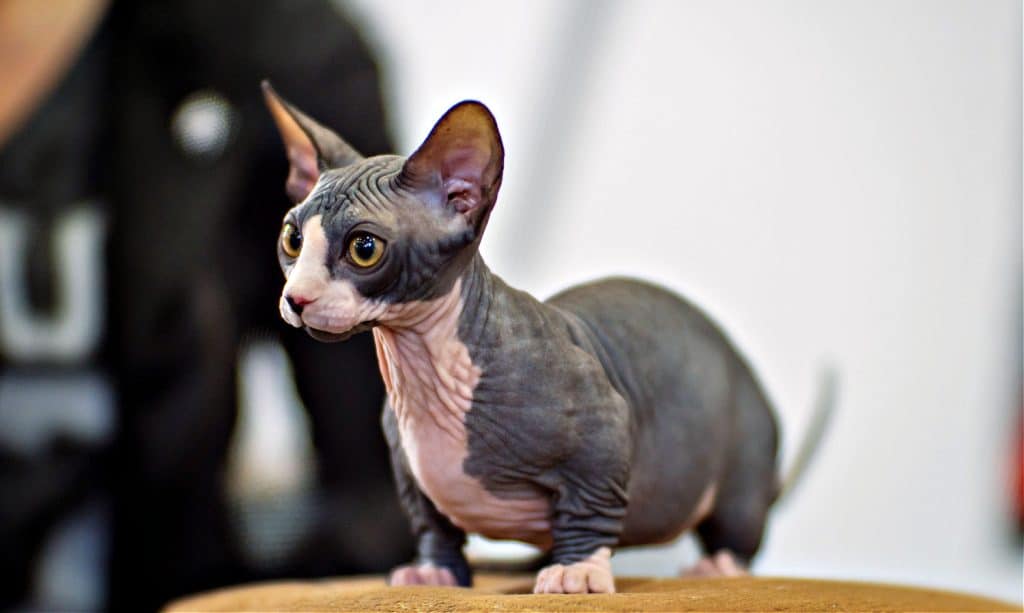
The Origins Of The Bambino: A Fusion of Genes
Also taking center stage on this National Nude Day is the Bambino - a breed with a remarkably unique and outlandish presence, conceived through the blend of the Sphynx and Munchkin cat breeds.
Aesthetic And Temperament Of The Sphynx
The Bambino's defining attribute is their absence of a conventional fur coat, a feature inherited from their Sphynx lineage. These distinctive cats are often found sporting a pink or gray skin tone, or sometimes a blend of both.
Their extraordinary and intriguing appearance has prompted comparisons to minute extraterrestrials, challenging traditional cat aesthetics.
Interestingly, the complex genetics of Bambinos mean some may possess a thin, downy fur layer over their skin - a unique inheritance from the Munchkin breed.
Nevertheless, this light fur does little to conceal Bambino's iconic wrinkled skin.
Bambinos, often presenting a robust build courtesy of their Munchkin parentage, are unexpectedly agile and active.
Their outgoing personalities, intelligence, and love for human interaction make them a delight as family companions.
Bambino Care: Essentials And Particularities
The Bambino's hairless skin, while setting them apart, also makes them prone to skin issues. Their exposed skin can quickly dry out, requiring regular gentle baths with mild soap and warm water to stave off greasiness.
Overbathing can intensify skin dryness, so caution is advised. Some Bambinos may even require a mild, fragrance-free lotion to preserve skin hydration.
Bambinos, lacking a protective fur coat, are particularly susceptible to heat and sunburn.
They can quickly overheat, placing them at higher risk of heat strokes than their furry counterparts.
Bambinos In The Home: A Domestic Angle
With their friendly disposition, Bambinos make outstanding family pets. They are gentle and welcoming towards children, smoothly adjusting to new family members.
Bambinos maintain a kitten-like demeanor throughout their lives due to their lack of fur, unusual aesthetics, and short legs.
Their lack of hair makes them perfect models for pet clothing, especially in cooler climates. The breed's playful and adventurous spirit often leads to fun-filled adventures.
Typically sociable, Bambinos can peacefully coexist with other pets, provided they are properly introduced and socialized.
Official Status And Controversies
Despite their hybrid beginnings, Bambino cats have official breed status. The offspring from the Osbornes' Sphynx-Munchkin crossbreeding in 2005 is recognized as a unique breed.
However, not all countries permit Bambino breeding due to concerns about potential genetic health problems, with Germany and the Netherlands imposing breeding restrictions.
Inconsistent Dwarfism
The Osbornes' ambitious mission to engineer a hairless cat with dwarf characteristics faced the unpredictability of genetics.
While the majority of Bambinos inherit short legs and exhibit dwarf traits, some may inherit the Sphynx's longer legs, thereby disqualifying them as a dwarf breed.
Hairless Breed #3: The Donskoy
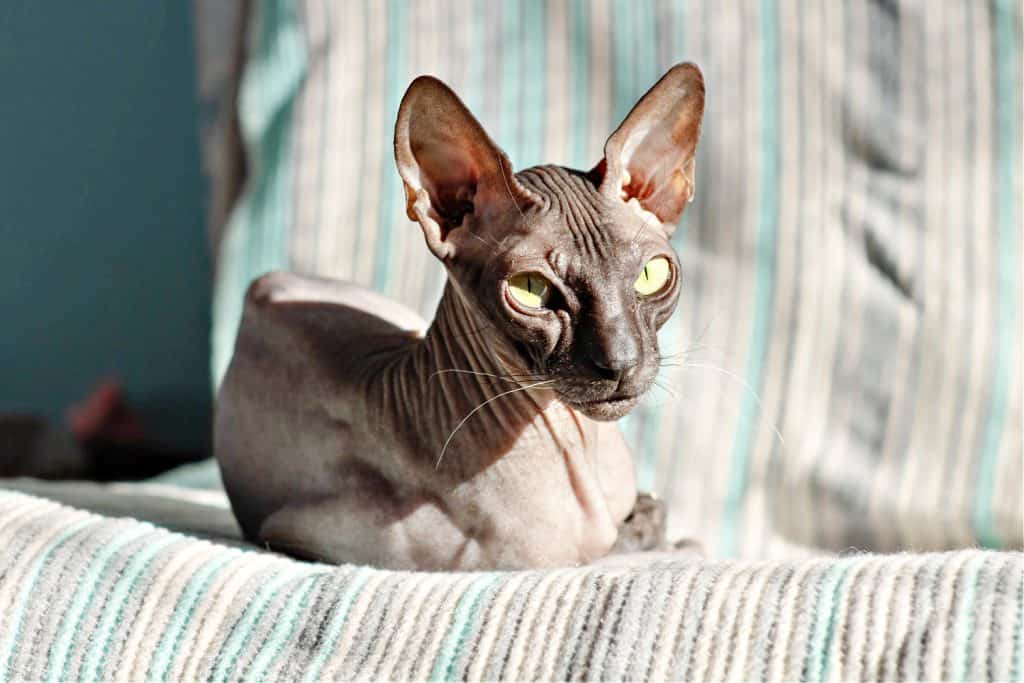
Getting To Know The Donskoy
The term "Donskoy" may seem unusual to some, but it resonates with the breed's intriguing Russian heritage.
Occasionally termed the Don Sphynx, owing to some apparent parallels with the more popular Sphynx cat, the Donskoy is, in fact, genetically separate from its Sphynx counterpart.
Some also refer to them as the Russian Hairless, aptly highlighting their notable absence of fur.
The Dawn Of The Donskoy
The Donskoy's origin story takes us back to 1987 in Russia, where Elena Kovaleva, a professor at the State Pedagogical Institute, stepped in to rescue a kitten named Varvara from a group of mischievous boys.
Despite numerous attempts to rectify Varvara's hair loss, the kitten remained hairless. Eventually, after a union with a local tomcat, Varvara produced a brood of furless kittens, which would become the foundation of the Donskoy breed.
The Art Of Being Hairless
Unlike the Sphynx, the Donskoy's hairless trait is a result of a dominant mutation. Despite this, Donskoys showcase varied degrees of hairlessness, dividing them into four categories: brush, velour, flocked, and rubber bald.
Brush-coated Donskoys boast soft, wavy fur, while the velour variety exhibits a bald head with a fur-clad body.
Flocked Donskoys have a thin layer of fur that may eventually shed, and the rubber bald Donskoys live up to their name, maintaining a bald appearance throughout their lives.
The Donskoy's Distinctive Physical Characteristics
Muscular and medium-sized, Donskoys stand out with their rounded necks and tails of medium length.
Additional physical traits include webbed toes and soft, cushion-like paws, lending them an enchanting, buoyant stride.
Donskoys' lack of fur poses challenges in body temperature control. Consequently, these felines are prone to discomfort in extreme heat or cold, and sun exposure could lead to sunburns.
As such, they are ideally indoor pets, thus safeguarding them from severe weather and harmful sun exposure.
Donskoys: Personality And Care Essentials
Beyond their unique looks, Donskoys possess unique personalities and care needs.
Contrasting with most cats, Donskoys thrive on companionship. They relish constant interaction, making them unsuitable for owners unable to provide continual companionship.
They are particularly affectionate, demonstrating love by snuggling into your arms or brushing against your legs.
Despite their adaptability to cohabitation with other pets, Donskoys might show signs of jealousy when the attention is divided, especially among other felines.
This can occasionally result in territorial or aggressive behaviors.
Despite these occasional jealous tendencies, Donskoys are generally mild-tempered, friendly, and gentle.
Additionally, Donskoys are known for their exceptional intelligence, being quick learners that retain new skills throughout their lives.
This curiosity and eagerness to learn require mental stimulation through toys, puzzles, and diverse activities.
Donskoys are generally quieter than other breeds, often communicating through physical cues and actions.
Living With A Donskoy: Lifespan, Diet, And Care
Despite their resilient nature, Donskoys have specific care requirements to ensure optimal health and longevity.
Contrary to popular belief, Donskoys need regular grooming despite their hairless condition.
Their skin, akin to human skin, requires daily cleaning and sponging. Routine bathing, nail clipping, and oral care are also integral parts of their grooming routine.
Donskoys are typically healthy, though they are susceptible to dental issues like gum disease and tooth decay.
Regular dental cleaning can help avert such problems, and extra caution is required to prevent sunburn due to their lack of fur protection.
Regular exercise is vital for their health and entertainment, making an indoor play area with a cat tree and various activities ideal.
Donskoys are medium-sized cats, standing about 10-12 inches tall, with females typically weighing between 4-7 lbs, and males a bit heavier at 9-11 lbs.
As they have higher body temperatures, Donskoys burn more calories and therefore require more food than other breeds.
With an average lifespan of 12-15 years, Donskoys can live even longer with proper care and a suitable environment.
Hairless Breed #4: The Elf
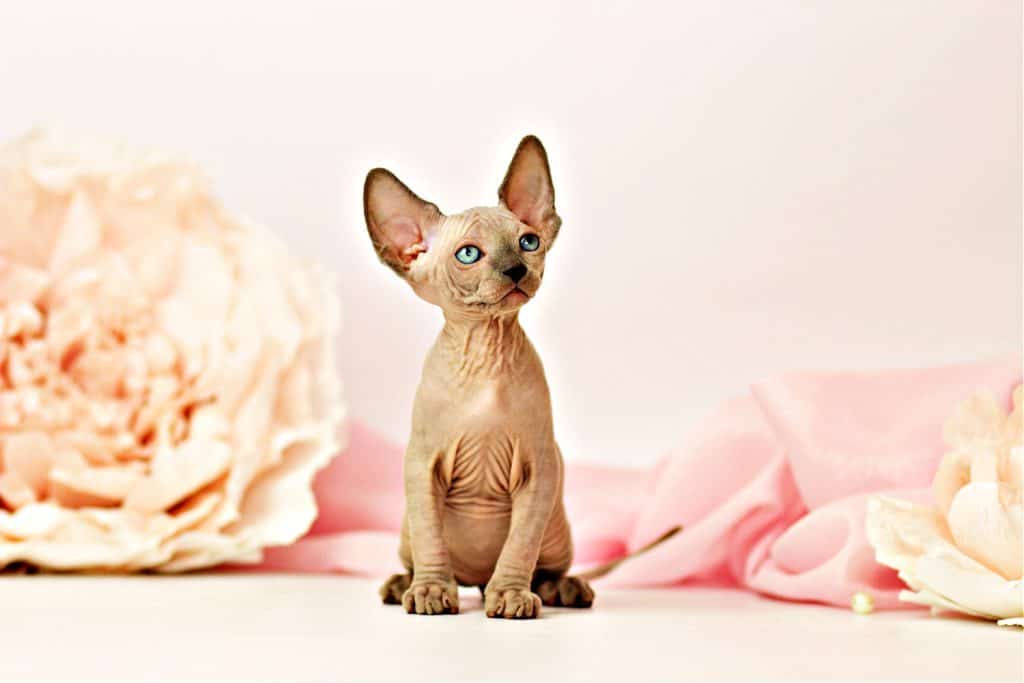
A Peek Into The Mystical World Of Elf Cats
Step into a fable as we unveil the Elf Cat, a breed seemingly plucked from the realms of enchanting storybooks.
As an intriguing mix of the Sphynx and American Curl, the Elf cat is an unfamiliar, yet enchanting breed that unites the Sphynx's sociability with the characteristic curled ears of the American Curl.
The Physical Attributes Of The Elf Cat
Elf Cats typically fall into the medium to large category, with males often weighing between 10 to 15 pounds and spanning 13 to 15 inches in length.
This breed is instantly identifiable by its hairless body, prominent cheekbones, and robust, athletic constitution. Their ears curl backward due to a genetic mutation, bestowing upon them their whimsical 'elfin' demeanor.
Despite their lack of fur, Elf Cats can sport an array of skin colors, including various shades of grey, black, beige, and pink.
Their skin may exhibit solid or patchy patterns, and their compelling eyes can range from captivating blues to inviting golds.
Gauging The Personality And Behaviour
Elf Cats are esteemed for their affable, placid temperament and remarkable adaptability to varying households and family setups. They are congenial with other pets and are known for their fondness of attention.
With their love for ascending to high surfaces and vaulting, they are a perfect match for owners willing to provide abundant interaction and an engaging play environment.
Tracing The Elf Cat's Roots
Elf Cats graced our world in 2006, thanks to the concerted efforts of breeders Karen Nelson and Kristen Leedom.
The breeders aspired to create a breed that inherited the curly ears while retaining the charming characteristics and physical attributes of the Sphynx.
The successful cross-breeding of the Sphynx and American Curl birthed the Elf cat - a hairless marvel with curled ears.
Despite its relatively recent history, the Elf cat has left a significant mark at cat shows organized by The International Cat Association (TICA).
However, it should be noted that the Elf cat is currently recognized as a variant of the Sphynx, and not a distinct breed.
Elf Cat Care
Due to their hairlessness, Elf Cats require specialized care. While they don't necessitate brushing, they do need regular baths and frequent cleaning to keep their skin in optimum health.
Compared to their furry counterparts, they necessitate more grooming, mainly because they can't self-groom effectively, especially within their many skin folds.
These felines also require a diet rich in calories to aid them in maintaining body temperature. Therefore, consulting a veterinarian to determine the correct quantity of food for your Elf cat is essential.
Generally, Elf Cats are healthy, but given their recent evolution, they may encounter some genetic health problems as the breed matures.
These could include skin conditions, ear infections, and difficulties in regulating body temperature due to the lack of insulating fur.
Despite their specialized grooming needs and the initial outlay, these cats are exemplary companions, promising years of devoted companionship.
Should You Adopt An Elf Cat?
The Elf cat, with its kind and playful temperament, makes for a splendid pet, but potential owners must be prepared to cater to its unique grooming and care requirements.
Despite these factors, their largely hypoallergenic nature and friendly demeanor make them a delightful addition to many households.
As with any pet, those considering welcoming an Elf Cat into their family should consider all relevant information to determine if this breed is the ideal fit for their home environment.
Hairless Breed #5: The Peterbald
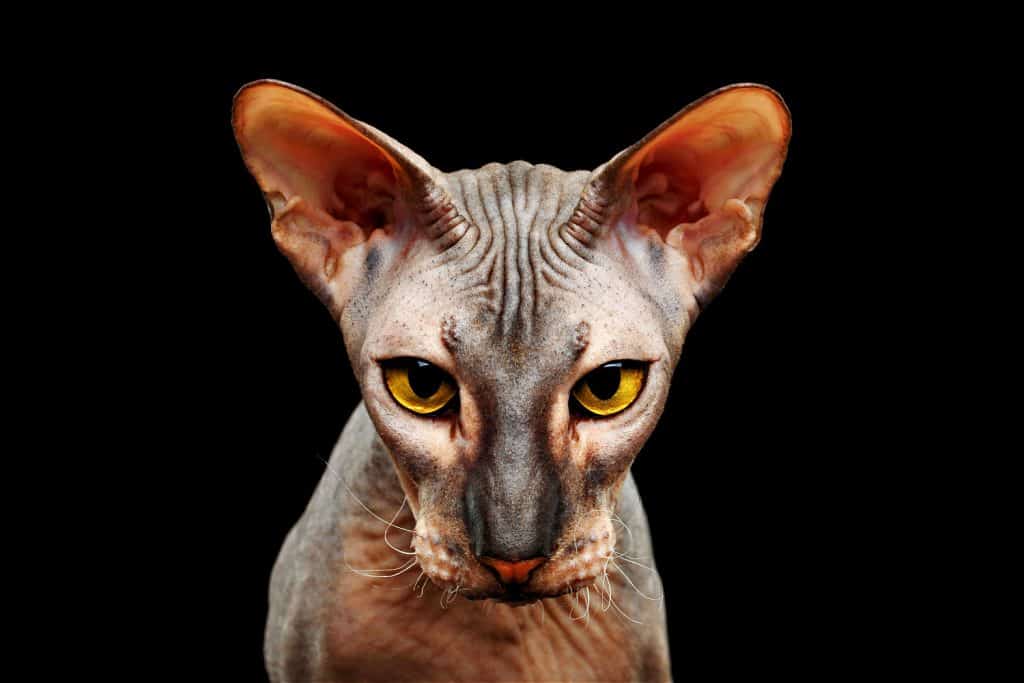
The Elegant Peterbald From Russia
Let's head over to Russia and acquaint ourselves with the refined elegance of the Peterbald.
Known for their slender bodies and touchably warm hairless coats, Peterbalds are the epitome of understated elegance, a captivating breed that's sure to leave you spellbound.
The Peterbald's Origin Story
Our hairless Russian friend, the Peterbald, traces its beginnings to St. Petersburg in 1994, where it was the result of visionary breeding by Olga S. Mironova.
The birth of the Peterbald breed was marked by the pairing of a male Don Hairless, also referred to as Don Sphynx, Donskoy, or Donsky named Afinogen Myth, and Radma von Jagerhov, a female Oriental Shorthair of World Champion status.
The breed gradually evolved, taking on traits reminiscent of modern Oriental and Siamese cats.
Recognition And Breed-Specific Regulations
In 1996, the Peterbald earned its stripes with formal recognition by the Russian Selectional Feline Federation (SFF), followed by acknowledgment from The International Cat Association (TICA) in 1997 and the World Cat Federation (WCF) in 2003.
By May 2009, the Peterbald ascended to Championship class competition, further cementing its status in the feline world. However, some restrictions apply to the breeding of Peterbalds.
For instance, as of 2014, the Netherlands has prohibited the breeding of cats with genetic mutations or physical abnormalities that could adversely affect the health or welfare of their offspring.
Given their hairless nature, Peterbalds, who lack protective fur, fall under this legislation.
Physical And Temperamental Traits Of Peterbald
Resembling the lean physique of Oriental Shorthairs, Peterbalds sport a slim yet muscular frame, an elongated head, almond-shaped eyes, a wedge-shaped muzzle, and large ears set wide apart.
They are also equipped with a long, whip-like tail and webbed feet, leading to oval paws capable of grasping objects and even manipulating lever-style doorknobs.
Peterbald kittens may be born bald, flocked, velour, brush, or with a straight coat, but over time, all except those with straight coats can become bald.
Their fur can manifest in any color or marking, offering a wide array of options for potential pet parents.
As for their temperament, Peterbalds are characterized by their sweet-natured curiosity and energetic disposition.
Medium vocal, they tend to shadow their owners, displaying deep affection for their human family members.
They generally coexist peacefully with other cats, pets, and children, making them an excellent choice for families.
Peterbald Trivia
The Peterbald boasts a dominant baldness gene, meaning that crossbreeding with other breeds can yield hairless kittens. The Peterbald is one of a mere six recognized hairless cat breeds worldwide.
Peterbalds can be born either bald or with fur in flock, velour, brush, or straight texture. Peterbalds born with fur often shed it in their early years, or their coat undergoes texture and length changes.
Known for their lively, friendly, vocal, and exceptionally affectionate nature, Peterbalds are entertaining companions.
These active, highly athletic cats revel in playtime with their human companions. Generally, Peterbalds are healthy cats and are not predisposed to major genetic problems. Peterbalds have an average lifespan of about 15 years.
Hairless Breed #6: Ukrainian Levkoy
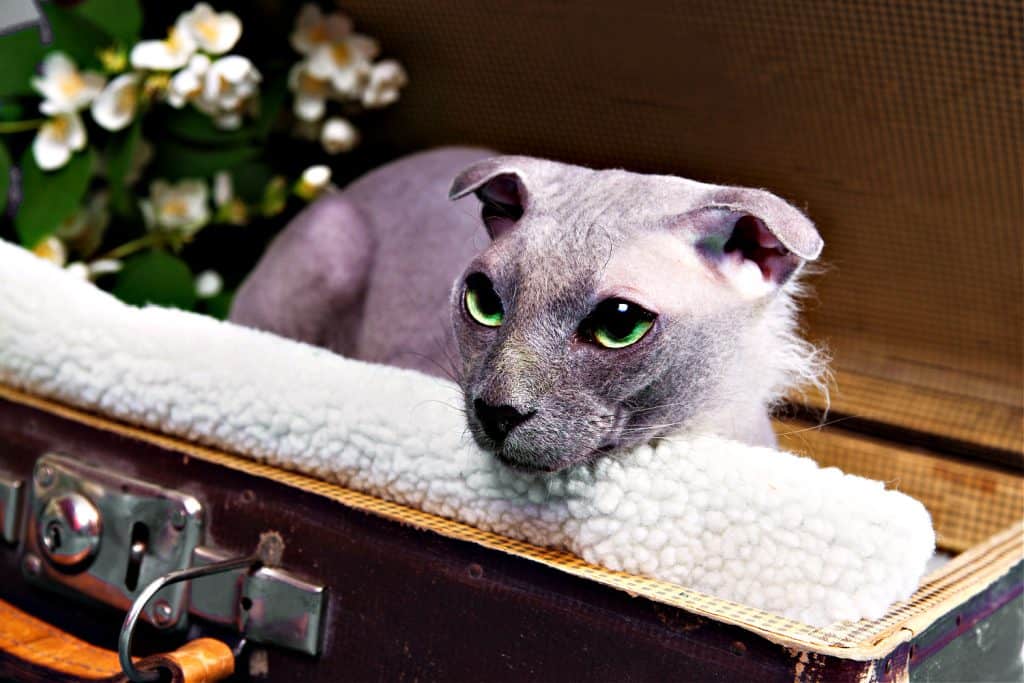
Dive into the peculiar charm of the Ukrainian Levkoy. Characterized by its intriguing folded ears and hairless silhouette, this breed elegantly bridges the gap between enchantment and elegance.
The Genesis Of The Ukrainian Levkoy
Emerging in the early dawn of the 21st century, the Ukrainian Levkoy is one of the newer members in the world of hairless cat breeds.
First officially recognized in Ukraine in 2000, this breed is an embodiment of an inventive crossbreeding endeavor.
The unique appearance of the Ukrainian Levkoy is the result of a deliberate cross between a Donskoy and an Oriental Shorthair.
It was this genetic blend that gifted the Levkoy with its distinctive attributes: the Donskoy's hairlessness and the Oriental Shorthair's angular face and wide-set ears.
The end product was a unique breed with an intriguing aesthetic, standing out in the hairless cat world with a persona as captivating as its appearance.
This breed was officially recognized in Ukraine in 2005 by the ICFA RUI (Rolandus Union International) and later in Russia in 2010 by the ICFA WCA.
Despite being a relatively new breed, Ukrainian Levkoys have already made a splash, earning titles such as "Champion" and participating in "The Best in Show" competitions.
Physical And Temperamental Traits Of Ukrainian Levkoy
As one of the rarest cat breeds, it can either have a bit of fur or be entirely hairless. Some Ukrainian Levkoys even have straight ears. Their coats can come in nearly any color and the most unusual color combinations.
The Ukrainian Levkoy also holds distinguishing traits that make it stand out in the feline world. Among these peculiarities are the angular shape of its head and a "stepped" profile, which give it a canine-like appearance.
Their ears, distinctively folded inward, and large, almond-shaped eyes contribute to their unusual charm. Furthermore, this breed exhibits sexual dimorphism, allowing males and females to be visually distinguished.
Ukrainian Levkoys feature a soft-outlined, pentagon-shaped head when viewed from above. Their profile is distinguished by two parallel running lines of the nose bridge and head.
Possessing a muscular neck that gracefully arches from the shoulder to the base of the skull, these cats embody grace and agility. The cats' bodies are medium to long, with a slightly arched back and a broad, oval chest.
The distinctive large ears set high and wide apart, along with their notably long legs, add to their overall striking appearance.
Ukrainian Levkoys, known for their sociability, playful nature, and intelligence, enjoy the company of humans and are friendly toward other domestic pets.
Tending To The Ukrainian Levkoy
Ukrainian Levkoys are not just intelligent and sociable felines, they're creatures of comfort that thrive in cozy, indoor environments.
These cats have an inherent sensitivity to extreme temperatures due to their lack of a fur coat. As such, a home that offers warm corners during winter and cool spaces in summer is crucial for their well-being.
Grooming and skincare are paramount when it comes to Levkoy's care. Their hairless skin, though an eye-catching attribute, makes them susceptible to certain environmental factors.
Direct sunlight, for instance, can cause sunburn, while harsh winter cold can lead to hypothermia. Regular baths to remove excess skin oils and the application of skin moisturizers are also important elements of their grooming routine.
A mindful blend of shielding and grooming, therefore, forms the bedrock of caring for a Ukrainian Levkoy.
Potential Breed Concerns
While the Ukrainian Levkoy's distinctive features make it a captivating breed, they also come with potential genetic issues. For example, the FD gene, which is responsible for the breed's folded ears, can occasionally lead to bone-related diseases such as arthritis.
Other traits that may result in disqualification from shows include structural defects, cross eyes, a too-short or round head, round eyes, a short "cobby" body, a weak chin, or stressful behavior.
Should You Adopt An Ukrainian Levkoy Cat?
The Ukrainian Levkoy merges an unusual physical appearance with a friendly, playful personality. They are one of the rarest cat breeds, and they possess unique abilities like opening cupboards and drawers.
They are ideal for those living in apartments and are known to develop strong bonds with their human companions. Their size, curiosity, and sociability make them a delightful addition to any cat-loving household.
Known for being kid-friendly, the Ukrainian Levkoy forms strong bonds with every member of the family. They are highly inquisitive and have an uncanny knack for opening cupboards and drawers.
Friendly, gentle, and loyal, the Ukrainian Levkoy enjoys spending its time exploring, playing with toys, and interacting with its human companions.
When it's chilly outside, you can find the Ukrainian Levkoy snuggling up for a long nap.
The Ukrainian Levkoy is medium in size, with males weighing between 4 and 6 kg and females weighing between 3.5 and 5 kg.
Hairless Breed #7: The Lykoi
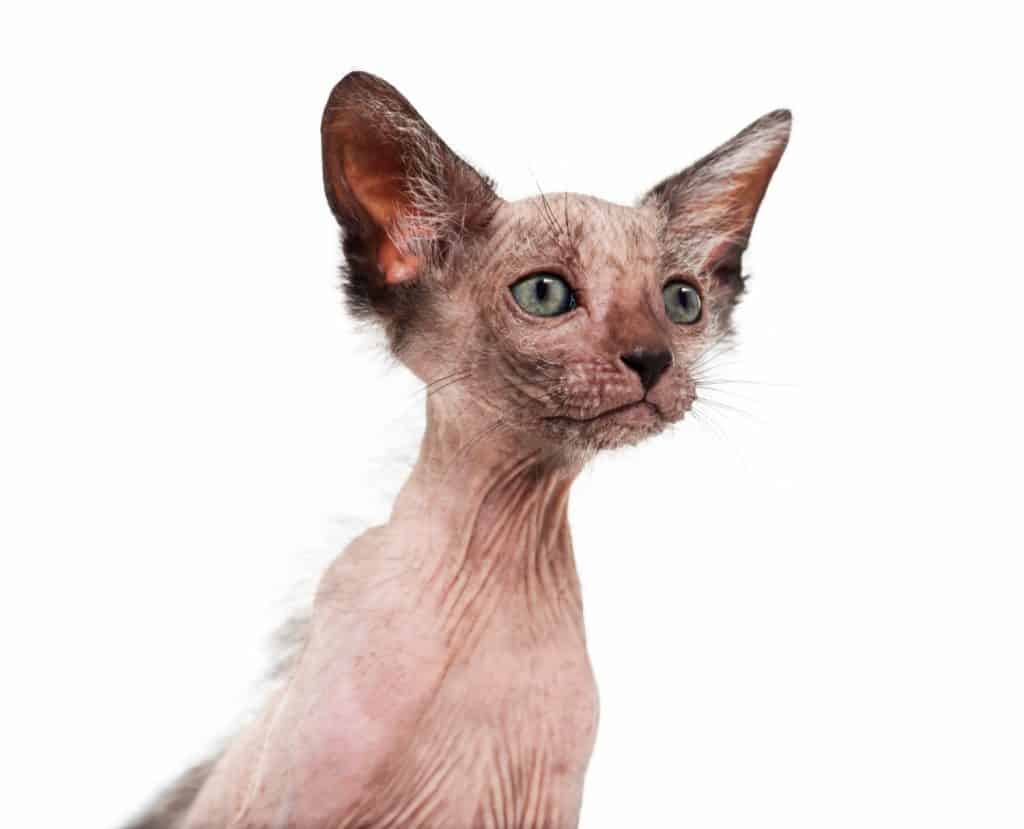
Introducing The Lykoi
As we continue our bare-skin celebration, it's time to unveil the mysterious charm of the Lykoi, affectionately called the 'Werewolf Cat'.
With its fascinating fur or the lack thereof, it takes on a compelling, wild persona.
The Lykoi: A Unique Twist Of Nature
Breaking from our narrative of carefully crafted breeds, we have the Lykoi. The striking look of this cat is not the product of deliberate selective breeding but rather a fascinating genetic quirk.
This breed's patchy, sparse fur is a result of a natural mutation causing hypotrichosis.
Discovered amongst feral cats in the United States in 2010, this genetic marvel first emerged in Tennessee. The unique wolf-like appearance of their coat quickly became their hallmark, captivating the attention of cat enthusiasts.
Their very name, 'Lykoi', a nod to their uncanny resemblance to wild wolves, is derived from the Greek word for 'wolf', further echoing their wild, alluring aesthetics.
The Physical Intricacies Of The Lykoi Cat
Lykoi cats possess an intriguing fur characteristic that varies from being fully furred to nearly hairless. Even more captivating is their ability to experience cycles of complete hair loss, akin to a Sphynx cat, and then regrow it later.
When they sport a coat, it strikingly resembles that of an opossum, adding another layer to their distinctive allure.
Yet, despite these physical quirks, the Lykoi cat's true charm lies in their friendly and playful nature.
These cats are not only eye-catching; they are ideal companions, displaying palpable affection for their human families.
While these cats can be almost hairless at times, their remaining patches of thin fur require careful attention. Contrary to what their sparse coat might suggest, Lykoi cats are not hypoallergenic and have particular grooming needs that can't be overlooked.
Yet, their upkeep is a small price to pay for their love and adaptability. Their docile demeanor and compatibility with humans, other cats, and dogs make them a delightful addition to any family dynamic.
Caring For The Werewolf Cat: The Unique Lykoi
Embodying an enchanting blend of intelligence, playfulness, and striking looks, Lykois, also known as Werewolf Cats, are truly one of a kind.
They may not be entirely hairless, but their distinctive, sparse coat gives them an undeniably captivating appearance.
This coat, however, comes with its own set of care requirements. Regular grooming is essential, including gentle brushing to keep their coat in good shape and to prevent skin issues that may arise from the unique nature of their fur.
Baths should also be part of their routine, but not too frequently, to preserve the natural oils in their skin and fur.
Lykois thrive on attention and affection. Showering them with love, coupled with interactive play and mental stimulation, is the best way to keep them happy and healthy.
These cats are sure to return your affection tenfold, making the care they require more than worth it!
Recognition Of The Lykoi Breed
The Lykoi breed traces its roots back to a couple of domestic short-haired cats that were discovered in the United States in 2010 and 2011, both carrying the Lykoi gene.
In 2012, the International Cat Association (TICA) registered the Lykoi, and by 2017, they were recognized as a Championship Breed.
Hairless Breed #8: The Minskin
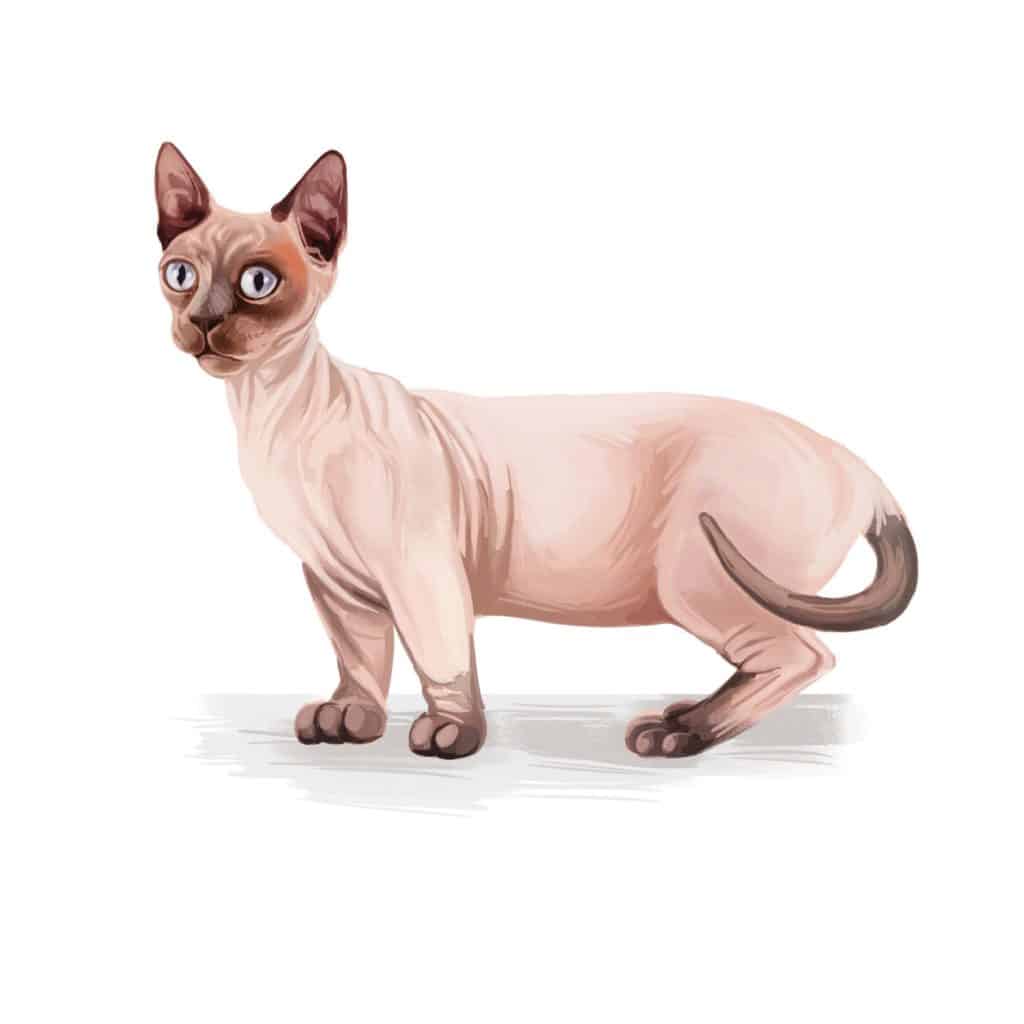
The Minskin: A Unique Blend
Let's turn our gaze to the Minskin, a compelling fusion of the Sphynx, Munchkin, Burmese, and Devon Rex breeds.
Born from the creative imagination of Paul Richard McSorley in 1998, the Minskin is a Boston native breed sporting a sparse coat, short legs, and dense 'points' of fur on the face, ears, legs, and tail.
McSorley's journey to create the Minskin involved crossing his coveted Munchkin show cats with hairless Sphynx cats, resulting in a breed that retained the fur on the 'points', a trait that contributes to a healthier immune system.
International award-winning Burmese cats and Devon Rex cats were also introduced to the breeding program, bringing an added dimension to the structure, temperament, and other desirable traits of the Minskin.
The fruition of McSorley's vision came in July 2000 with the birth of the first cat fitting his conception, named "TRT I Am Minskin Hear Me Roar."
Minskin Recognition: Making Its Mark
Fast forward to 2005, the Minskin breed had multiplied, boasting around 50 cats fitting McSorley's vision. This milestone led to their registration by The International Cat Association (TICA).
In 2008, TICA further recognized the Minskin as a Preliminary New Breed (PNB), paving the way towards an Advanced New Breed (ANB) status and ultimately, Championship recognition.
The Minskin has also gained recognition from the World Cat Federation (WCF), making it one of the select few breeds acknowledged by both federations.
This acceptance was largely due to the unique "Fur-Points" of the Minskin, describing the dense rex fur on the mask, ears, legs, and tail, contrasting the sparser torso fur.
Characteristics And Personality Of The Minskin
The Minskin, a small to medium-sized dwarf breed, is characterized by a semi-cobby, muscular body, a round head, wide-set ears, and large round eyes that portray an alert demeanor.
The "fur points" remain a distinguishing feature, giving the cat an alien-like appearance while providing a cashmere-like texture on their torso. These "Fur-Points" highlight densely packed rex fur on the mask, ears, legs, and tail.
Despite their unusual looks, Minskins are endearing and playful, needing minimal grooming and cohabiting well with other pets and humans.
Their loveable nature and intriguing physical features make them fantastic companions for diverse households.
Minskin cats are known for their agility and love to run, jump, and climb. They possess remarkable intelligence, facilitating early training. Known for their curious nature, Minskins will often explore every nook and cranny of your home.
A Minskin typically weighs between 4-6 pounds, with a life expectancy of 12-15 years.
Optimizing The Health Of A Minskin: A Delicate Balance
Due to their sparse fur, Minskins are uniquely suited to a comfortable indoor lifestyle. They flourish in warm, cozy environments, away from harsh external conditions that can compromise their skin health.
Regular baths play a crucial role in their care routine, aiding in keeping their skin clean, hydrated, and healthy, helping to prevent possible skin infections.
Nurturing an environment that matches Minskin's congenial nature is key to their well-being. Minskins are not just appealing for their distinctive physical characteristics but also for their friendly and sociable disposition.
Ensuring they have ample opportunities for interaction and mental stimulation is essential for their overall health.
Hairless Breed #9: The Dwelf
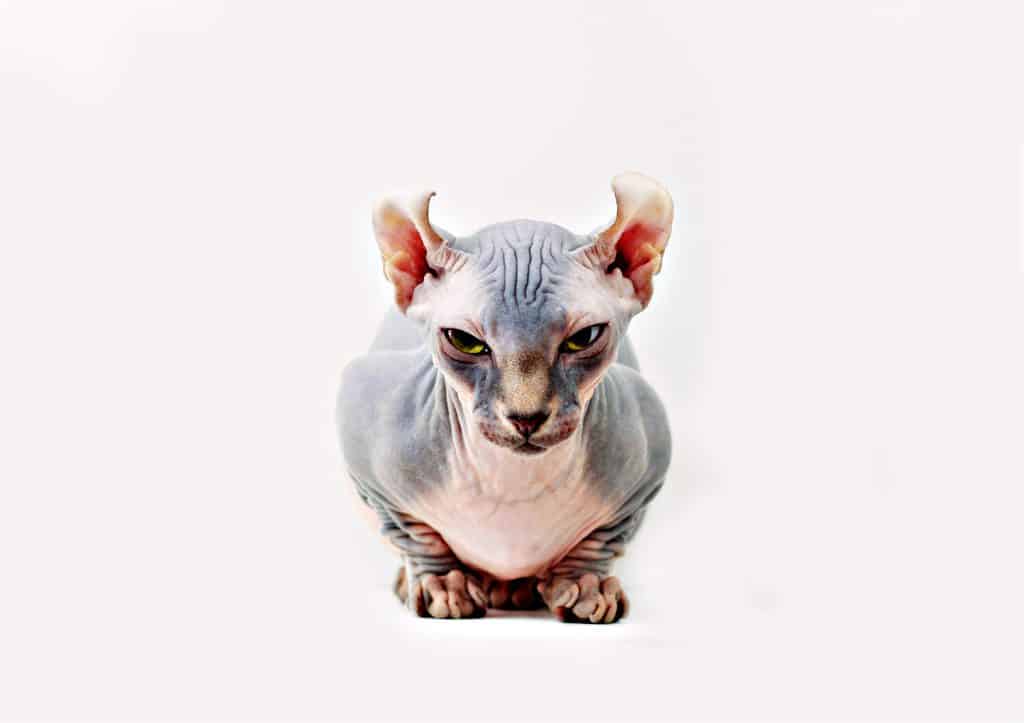
The Dwelf: A Fascinating Feline Fusion
Step into the world of the enchanting Dwelf cat, a creature that combines the attributes of the Sphynx, American Curl, and the Munchkin.
Its existence is a testament to the marvels of feline genetic diversity, incorporating longhaired and shorthaired domestic cats as well as Minshin and Bambino breeds.
Introduced in the 2000s, this hairless, curly-eared breed with a playful spirit is indeed a captivating spectacle.
The Dwelf's Distinct Features And Personality
The Dwelf is a robust little bundle of joy, carrying a round belly and an athletic physique wrapped in hairless skin.
Their faces, reminiscent of the Sphynx, flaunt short snouts, wide eyes, pronounced cheekbones, and strong chins, some even adorning whiskers and eyebrows.
The contrast of their robust bodies, muscular necks, and slight front legs ending in oval paws brings a unique charm to this breed.
Their long, whip-like tails and notably large curled ears add a touch of grace to their compact form.
Though small in size, Dwelf cats radiate immense energy and intelligence. They are social butterflies and cherish human interaction.
Their inquisitive nature drives them to explore their surroundings, making them an engaging companion.
Navigating The Dwelf's Health And Care
While the Dwelf seems a robust breed, its health parameters, given its recent development, aren't fully mapped.
Potential health concerns include common Sphynx breed issues like Lordosis, Pectus Excavatum, and Hypertrophic Cardiomyopathy (HCM), as well as skin and ear infections, and possibly degenerative joint disease due to their petite stature.
Dwelfs require a diet high in calories to compensate for their lack of fur and maintain body temperature.
Despite being hairless, they demand more grooming than an average cat, necessitating regular baths and post-bath drying to avoid skin complications.
Their care regimen also includes routine ear cleaning, nail trimming, and teeth brushing.
Endearing Yet Elusive: Adopting A Dwelf
The charm and vivacity of the Dwelf make it a beloved choice among cat enthusiasts. Adopting a Dwelf is a rewarding experience, with their vibrant personality providing years of companionship.
Delightful Dwelf Trivia
The Dwelf name is a portmanteau of 'dwarf' and 'elf,' indicating its small stature and aristocratic charm. The breed's short legs are a gift from the Munchkin lineage, and its curled ears are a feature of the American Curl.
Friendly and sociable, Dwelfs seek attention and thrive with ample human interaction. Dwelf cats need to stay indoors due to their hairless skin.
Despite their petite size, they possess a lively, clownish demeanor, resembling their Sphynx counterparts. Dwelfs flourish in homes where they receive plenty of attention from their human family members.

Adopting A Hairless Cat
As we bask in the aura of National Nude Day and marvel at the striking beauty of these hairless cats, it's crucial to remember that many of these cats are looking for loving homes.
Let's take a moment to celebrate the 'bare' truth: Adoption can be a far more rewarding journey than shopping for a pet.
The Joy of Adoption
The joy of welcoming a new fur-less friend into your family doesn't have to begin at a pet store. These endearing cats, full of charm and personality, can be found in shelters and rescue organizations nationwide.
So, as we honor the 'naked' beauty of these hairless breeds this National Nude Day, why not consider giving one of these cats a loving home? Let the love unfold organically, and you'll see, it's the 'bare' necessities that truly matter!
Where To Adopt A Hairless Cat
While you might be falling head over heels for these hairless heart-stealers, it's important to know where you can find them.
So, here are some organizations that offer hairless cats for adoption:
- Petfinder: With connections to thousands of shelters and rescues across the country, this platform offers a great starting point for finding your new fur-less friend.
- Sphynx Open Arms Rescue (SOAR): This dedicated non-profit organization takes care of our hairless wonders, fostering Sphynx cats and protecting them until they find their forever homes.
- Hairless Galaxy: This platform is a haven for those looking for hairless cats for adoption.
- Adopt-A-Pet: As a nationwide network, this site allows you to search for rescue groups near you and meet your new best friend.
- Rescue Me! Sphynx Rescue: With a fantastic rating from numerous reviews, this non-profit organization has earned its reputation through its devoted service to the Sphynx cats under their care.
The 'Bare' Reality
There's something extraordinarily gratifying about adopting a pet. It's not just about saving a life; it's about offering a second chance, a new start, a loving home.
This National Nude Day, we encourage you to embrace the 'bare' reality. Adopt, don't shop! And remember, the only thing better than the warmth of a furry friend is the warm heart of a fur-less one!
Hairless Cats Are Stars On National Nude Day
And there we have it - our tour of the wonderful world of hairless cats comes to an end this National Nude Day.
Each of these hairless breeds has its own unique look, interesting story, and special charm. They remind us that cats don't have to be fluffy to be beautiful.
We hope that by highlighting these cats, we've got you interested in them too. If you're thinking about getting a cat, why not consider adopting one of these hairless breeds?
Yes, they may need a bit of extra care, but the happiness they bring makes it all worth it.
So, on this unique day, let's cheer for these hairless beauties. They show us that cats can be beautiful in many different ways.
Happy National Nude Day to our naked cat friends, and to all those who love and care for them.
You might also like:
9 Cat Breeds with Stunning Blue Eyes! Do you know them all?
A Cat’s Hilarious Case of Mistaken Identity – You Won’t Believe Your Eyes!
Some elements on this page may have been created by our team using advanced AI to provide you with top-notch cat inspired ideas. Read more about our AI Content Policy.
